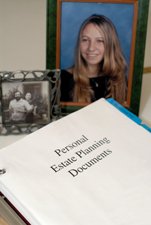Learn the Importance of an Estate Planning Checklist

An estate planning checklist is an excellent tool for planning the future. Keep these things in mind when developing your own checklist:
- We all have assets and debts
- Knowing where you stand financially is important
- This checklist can help you get a clear picture of your finances
- Download a boilerplate form, or customize your own
- Use the form to list all of your money and property, as well as debts and liabilities
No matter how humble or how grand your means, every family has certain valued possessions. These might be items of sentimental value, of monetary value, or both. These include items like your home, vehicles, jewelry, furnishings, and so on.
If you're like most families, you also have debts in addition to your assets. It's the rare person who is able to remain entirely debt free throughout life. Times may be tough, so you borrowed to fill in the gaps. Or, perhaps you simply spent a little too lavishly and now you owe money.
The balance between your assets and your debts is called your net worth. And this is an important thing to think about when it comes to planning for your family's future, since your spouse, children, or others close to you will at some point inherit the things you leave behind.
An estate planning checklist is one tool that can be quite useful when it comes to tracking your assets and debts. If you have an attorney assisting you in this process, a checklist for your estate is even more critical. This form will help you get a clear picture of your finances so that you can appropriately plan for the future.
Fortunately, it's simple to download any of these checklists from the Internet. You'll find a wealth of information and forms that can help you compile and organize your personal information. Typically, these forms will include questions about the items you own, as well as loans, mortgages, and other debts. You'll list important information concerning when and how you acquired your property, in whose name it is owned (jointly or individually), the current market value of your properties, and how much you owe against them.
A proper estate planning checklist will also include a section on the people or institutions with whom you have financial contacts. For example, you may have a financial adviser, broker, or a stock portfolio with a certain company. All of this information is crucial for getting a clear picture of your financial stability and economic activity.
Here's a simple checklist to use when developing your estate planning checklist:
- Money: List all bank accounts by type and account number include contact phone number for bank along with your balances and interest rates.
- Safety Deposit Box: List bank, account number, location of key, what's in the box, etc.
- Funeral Planning Checklist: Put one together and let your relatives know where it can be found when needed.
- Property and vehicles: List all property and vehicles owned. Include equity and any outstanding debt.
- Mortgages on property: Include the property location, the mortgage holder, account number, contact phone numbers, and remaining debt.
- Investments: Personal and through work. List out by type, account number, contact person and phone number, and balances.
- Insurance: List all policies such as life, disability, property and casualty with contact names and phone numbers of agents, and policy numbers.
- Will: List the executor along with their contact phone number.
If you have a very simple estate, or conversely a very complex one, you want to avoid boilerplate forms and instead opt to create your own estate planning checklist. This way, you can tailor the form to your specific needs. The most important thing is to look at it as an inventory, and list every single item of value that you own, including personal property, real property (real estate), cash accounts, stocks, retirement accounts, mutual funds, and any other type of account you may own.
Using an existing estate planning checklist that you can easily find online, or creating your own, is an excellent way to get a handle on your assets and liabilities. This is an effective tool that can simplify your future planning, and help you take charge of the legacy you'll leave for your family.
Return from Estate Planning Checklist to Home Filing System






